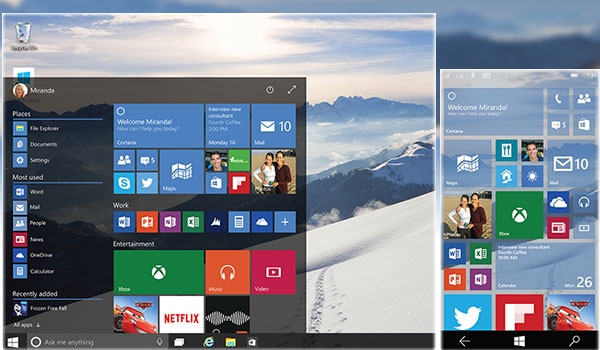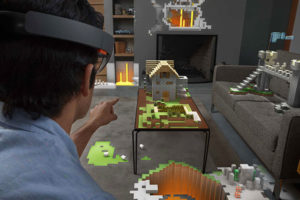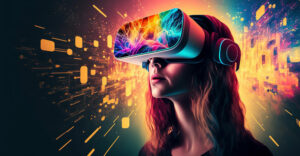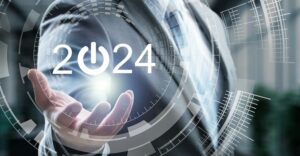I was one of the launch analysts for Windows 95, and the launch of that product is widely held — including by Bill Gates — as the company’s pinnacle. No launch before or since ever came close to that launch, and I remain amazed that no one, including Apple or Microsoft, has ever really attempted to duplicate that effort.
Windows 10 has the potential to be even greater than Windows 95 — but potential alone won’t a legendary product make. It’ll come down to execution, not just on the product, but on the launch itself.
I’ll close with my product of the week: the Microsoft HoloLens, which has the potential to take us one big step closer to something we call the Singularity.
Remembering Windows 95
The Windows 95 launch cuts very close to the heart for me, because Bill Gates and Windows 95 made me as an analyst. Windows 95 is how I got to know Don Clark over at The Wall Street Journal, and that wasn’t a good thing, initially — it almost cost my job.
That was when IBM told me I would be unemployable, and Sun, SGI and Novell all lined up with only one thing on their plate — to get me fired. That was the year Bill Gates personally stepped in twice — once to save my job, and the second time my reputation. The Windows 95 launch year is one I’ll never forget.
The ramp to the launch was amazing. At one point, I was doing near-daily TV interviews on the product, and the excitement approaching the launch day was bigger than I’d ever seen. I was in one really stupid video where they asked if the product would change my sex life, and I’m exceptionally grateful that Bill Gates himself killed it.
The launch itself was magical — the clouds in the sky even matched those on the box. With tents spread out across the Microsoft campus, it felt more like a revival meeting than a product launch. (I should point out that Steve Jobs regularly created the same feel but never at this massive scale).
On my return flight, a woman in front of me on the plane stairs forced me to step sideways, causing me to sprain my ankle so badly I couldn’t walk. That became a harbinger for the support disaster that likely kept Microsoft from making the same mistake again. You see, after the launch, virtually everyone who could make a decision went on vacation, and to keep the support lines short, the woman who headed support gave those holding the busy signal. Millions went from ecstatic to pissed off overnight, but that wasn’t the fault of the product or launch team (except maybe the vacation part).
However, Windows 95 was the last time I saw Microsoft bring out a product as a company, not a division, with marketing dialed in from the beginning. The company was customer-focused back then, and the user’s needs were a primary driver. And Brad Chase and Brad Silverberg were running the show under the legendary Bill Gates. It was an amazing time. Who knew it would go downhill from there?
Windows 10
During my visit with Microsoft last week, I was reminded of Windows 95 in that there was a huge focus on explaining several crucial things: that marketing was again being built into the front of the process rather than being an afterthought; that the user was again front and center for the requirements; and that people were again asking the question “why,” as in “why are we doing this?” — as opposed to just focusing on creative ways to explain “what we are doing.”
You see, in companies filled with engineers, products tend to become science projects more than things for real people. Folks do things because they can — because they want to see what will happen or simply because they want to showcase they have the authority, regardless of how foolish they are. So increasingly, you get products that suck. During the 2000s, that was the case at Microsoft. (We can the same about most of the products Google built rather than bought during that decade.)
Satya Nadella’s Microsoft is a very different company, though. People are working together again, engineers aren’t playing the “who can be the biggest wrong assh*le” game anymore, and the product looks amazing as a result.
The user interface is an improvement over Windows 7, not just different. It moves between tablet and PC mode when the user moves, not based on whether Office is in use or not, and it understands that users do stupid things and has their back. For instance, if you get a new PC with McAfee and let the subscription expire, rather than allowing you to be unprotected, Windows Defender will automatically step in and cover your butt.
Xbox (which I’ve long believed was one of the stupidest things Microsoft ever did, because it took gaming off its premier Windows offering and put it on a product initially sold at a massive loss) now is part of Windows. Instead of competing, it enhances the experience.
Windows 10 gets rid of the competing mail clients. It gives you a browser choice that makes sense — legacy for old stuff, and advanced for folks who like stuff cool and new — rather than the choice in Windows 8 that never made sense. It comes with good core productivity capability, so it works out of the box and Office looks like it belongs on the product.
It is vastly easier than any prior Windows product to upgrade too, and it will be even easier to upgrade going forward. Oh, and finally, for those on Windows 7 or newer platforms, it’s free.
Even the OEMs are excited about this offering — and too often at this point, they are just hoping the new version of Windows won’t hurt sales so much that it costs them their job.
Wrapping Up: Windows 10 Is Windows 95’s Brother by Another Mother
In short, in terms of potential, Windows 10 goes well beyond Windows 95’s capabilities. Granted, everything is relative and we have higher expectations now — but even taking that into account, Windows 10 feels well above Windows 95 in terms of capability. The excitement hasn’t hit yet, though. At this time during the Windows 95 rollout, there was much more.
Things move faster now than they did two decades ago — exactly two decades ago — so there is still time, but Microsoft has to step up. Windows 10 is good enough for people to line up for. Within six months, we’ll see if Microsoft can step up with a launch program that is worthy of this product’s potential.
Product of the Week: Microsoft HoloLens

With the Microsoft HoloLens, I really don’t think Microsoft knows what it has created. This is potentially even more disruptive than the Apple II was in its day — but as with the Apple II, folks are looking at the small picture, not the big one.
Not that the small picture isn’t interesting. The ability to place and eventually 3D-print things by blending the real and he virtual into an advanced augmented reality experience is pretty amazing. However, it pales against the potential this has to completely change how we use a computer.
Today, whether we are using a smartphone, tablet or PC, we have little human/machine integration. We use a keyboard or mouse, and we have to look at a display, which gets in the way of doing anything else we otherwise might be doing. The use of the computer disrupts life — it doesn’t integrate with it. The Hololens is the next major step in human/machine integration.

You interface with it largely with speech and gestures — no keyboard. The display moves where you look, and your eyes move the cursor. Because it is on your head and always in view, you can use it seamlessly to augment what you are doing by getting directions, having it tell you information you need when you need it, and showing you things all without having to change whatever else you may be doing.
It eventually will be able to enhance your vision and your memory, allow you to instantly see what others see from their perspective and them from yours, and it will be able to provide real-time advice on anything — from how to cook or fix something to what to say to a new date (including recalling her name, something I once forgot out of nervousness).
It’ll show you worlds that are limited only by imagination and help you build those worlds, and it will protect you and those around you by calling help or allowing others with the device to help you with the power of the Web or a remote specialist, always available to assist.
In short, the Microsoft HoloLens has the power to change computing as we know it, and to change us in unique, powerful and amazingly beneficial new ways. It could be the product of the century, but for now, the Microsoft Hololens is my product of the week.

























































Loved this article. I was around for the 95 launch as well and the excitement really was palpable. Great to see Microsoft moving back to a more customer-centric approach to software development.